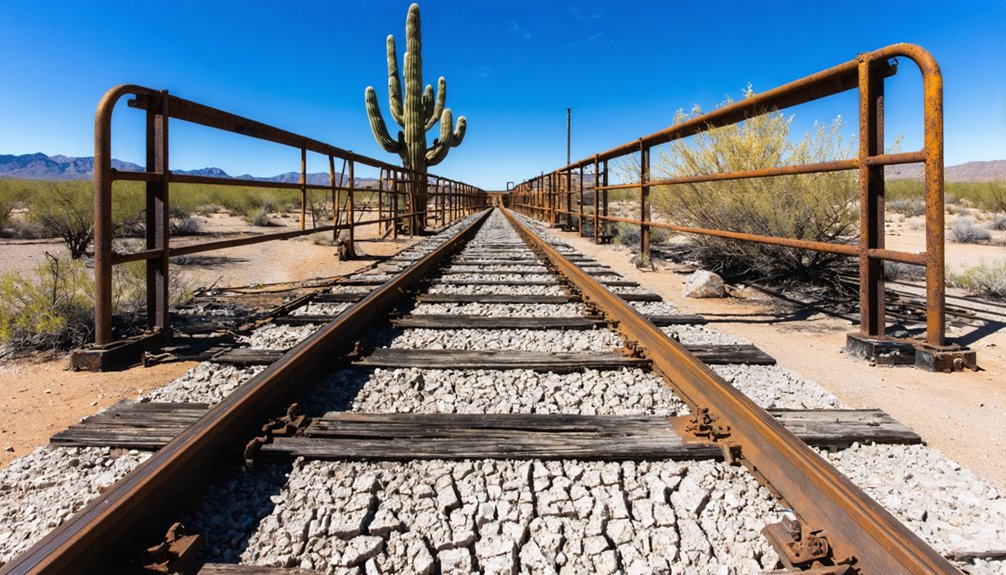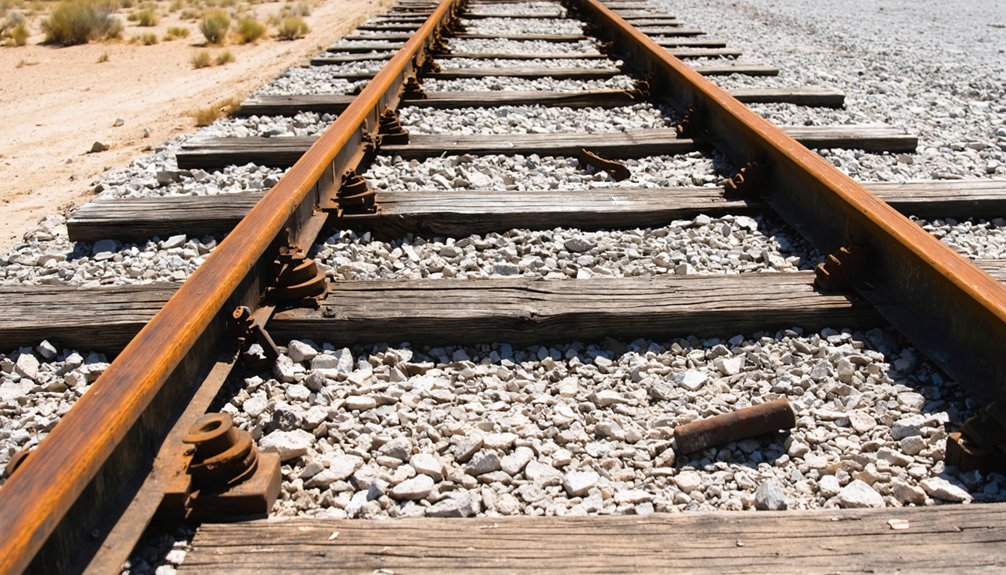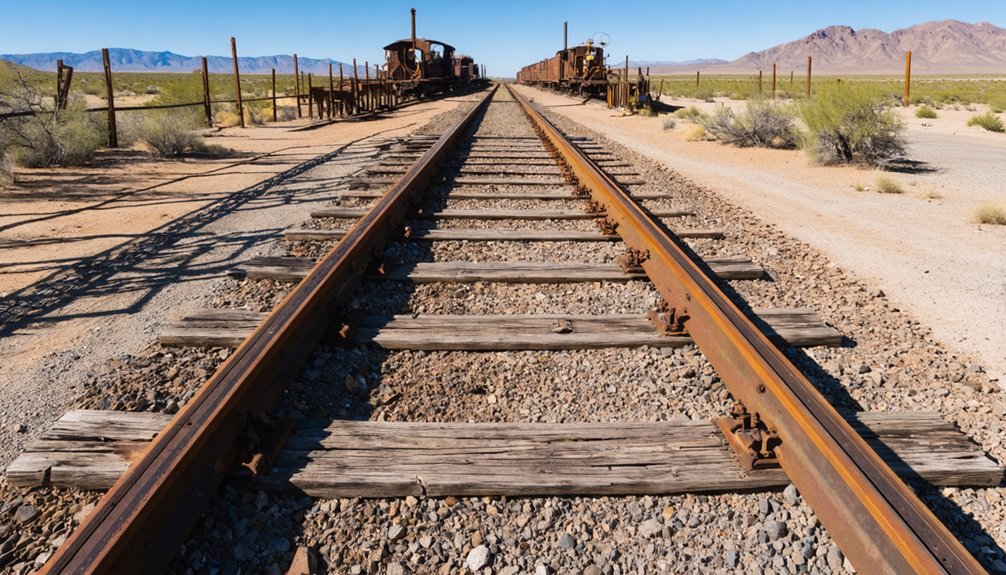You’ll find scattered remnants of Arizona’s abandoned rail stockyards beneath desert sands—weathered loading chutes, concrete foundations, and water management systems that once supported the booming cattle industry from 1915-1943. At Hewitt Station along the Magma Arizona Railroad, archaeological treasures include narrow-gauge track fragments and corral remnants. These silent structures reveal how railroads transformed Arizona’s economy before trucks rendered them obsolete during World War II. The desert preserves their stories.
Key Takeaways
- Archaeological remnants include rail ties, loading ramp fragments, and corral remnants beneath desert dust and weathered timbers.
- Concrete reinforcements in Johnson Canyon and the Arizona Mineral Belt Railroad tunnel still stand as symbols of industrial mining vision.
- Hewitt Station’s sophisticated water management system and loading chutes remain as evidence of historical livestock operations.
- Digital documentation efforts are preserving these historical sites despite ongoing urban development and natural deterioration.
- Loading chutes and durable holding pens designed for handler and livestock safety can still be found at former stockyard locations.
The Rise of Cattle Transport on the Magma Arizona Railroad
While primarily constructed to service the booming copper industry, the Magma Arizona Railroad quickly established itself as a vital artery for cattle transport following its 1915 inception.
You’d find the 3-foot narrow gauge tracks initially limited capacity, but the 1923 conversion to standard gauge revolutionized regional cattle routes, connecting Superior’s ranchers to national markets.
The railroad’s strategic 30.2-mile connection with Southern Pacific’s mainline transformed livestock economics throughout the Apache Leap region.
When steel met copper country, a 30-mile lifeline rewrote the economic destiny of Arizona’s rugged Apache Leap rangelands.
Before the rails, you’d rely on burros and 20-mule teams to transport your stock—an inefficient and costly endeavor.
The rail impacts were immediate: scheduled livestock runs became the lifeline of regional ranchers, creating a transportation network that would sustain Arizona’s cattle industry for decades while complementing the railroad’s copper-hauling operations.
BHP’s purchase of the railroad in 1996 led to the suspension of operations just one year later, ending the historic cattle transport era.
With Resolution Copper’s recent discovery of a massive copper ore body, the potential railroad revival would dramatically transform cattle transportation options once again.
Hewitt Station: Hub of Livestock Operations
At Hewitt Station, you’ll find a masterfully designed water management system that served as the livestock hub’s lifeblood during Arizona’s punishing summer months.
The loading chutes, constructed with graduated inclines and solid wooden sides to prevent animal distress, represented the pinnacle of late 19th-century livestock handling engineering.
Your observation of the site today reveals the fascinating convergence of rail and ranching technologies, where cattle-specific infrastructure merged with the industrial precision of Arizona’s expanding railroad network. The station played a critical role in Arizona’s cattle industry, which experienced explosive growth from just 30,000 head in 1870 to over 500,000 by 1886.
Jim Herron, a notable Arizona rancher, received his education at the Hewitt Station school before going on to manage significant cattle operations in the region.
Strategic Water Source Location
For successful livestock operations across Arizona’s rugged terrain, access to reliable water sources remained the paramount concern that dictated the strategic placement of rail facilities like Hewitt Station.
While specific details about Hewitt Station’s water infrastructure aren’t documented in available records, you’d recognize the historical significance of such facilities by understanding broader regional patterns. Arizona stockyards invariably positioned themselves near dependable springs, wells, or diverted watercourses—essential for thousands of cattle awaiting transport.
Water sourcing technologies evolved from simple catchment systems to sophisticated pumping operations as rail commerce expanded. The post-war slump significantly affected the infrastructure development at many stations during the 1920s. Each yard required calculations balancing livestock density against available water reserves, particularly during drought periods.
These engineering decisions often determined a station’s long-term viability in Arizona’s challenging climate, where freedom from water constraints meant economic survival.
Loading Chute Engineering
The engineering of livestock loading chutes at Hewitt Station represented a remarkable fusion of practical ranching knowledge and industrial efficiency during Arizona’s territorial expansion.
While specific historical records about Hewitt Station’s loading chute design remain elusive, similar facilities typically featured graduated wooden ramps that accommodated cattle’s natural tendency to walk uphill. These structures were precisely angled to minimize resistance while maintaining safety for both handlers and livestock.
The rail stockyard infrastructure at such stations generally incorporated holding pens constructed with sturdy juniper posts and mesquite planking—materials selected for their durability against both harsh desert conditions and the constant pressure of restless cattle.
You’ll notice that these abandoned loading facilities, when discovered, reveal the thoughtful engineering that once facilitated the systematic movement of Arizona’s primary territorial commodity to distant markets. The completion of the Southern Pacific Railroad in 1881 revolutionized these stockyard operations by making livestock transportation economically viable across previously inaccessible territories.
Transportation Technology Convergence
Hewitt Station emerged as a pivotal hub where traditional ranching practices met industrial-age rail transportation, creating one of Arizona Territory’s most significant livestock nexus points.
The convergence of rail infrastructure and ranch operations transformed how you’d move cattle from remote ranges to urban markets.
When you visit these abandoned yards today, you’re standing where the Magma Arizona Railroad once connected over 30 miles of territory, upgraded from narrow to standard gauge by 1923 to handle heavier livestock shipments.
The transportation logistics were masterfully designed—rail sidings, specialized loading facilities, and multimodal connections minimized transit times and animal stress.
This technological marriage supported the Hewitt Cattle Company’s massive operation of 200,000 livestock across millions of acres, exemplifying the industrialization of Western ranching.
The system embodied the Hewitt family’s philosophy to feed the world with sustainable practices while adapting to changing agricultural industry dynamics.
Engineering Marvels: Narrow Gauge Tracks and Loading Chutes
While standard rail lines dominated America’s primary transportation corridors, narrow gauge railways emerged as ingenious solutions to Arizona’s challenging topography, with tracks measuring just 3 feet between rails rather than the standard 4 feet 8.5 inches.
You’ll find these engineering marvels particularly prevalent in mining districts like Jerome, where the United Verde and Pacific Railway conquered severe 24-degree curves and 3% grades that would’ve been impossible with standard equipment.
- Narrow gauge advantages included lower construction costs, tighter turning radii, and adaptability to mountainous terrain where standard gauge couldn’t economically venture.
- Cattle chute design evolved alongside these railways, with specialized structures like Hewitt Station’s loading ramp facilitating efficient livestock transfer.
- These engineering solutions reflected the pragmatic spirit of western expansion, balancing technical limitations with operational necessities until trucking rendered them obsolete.
The Magma Arizona Railroad’s decision to initially build with narrow gauge was driven by cost efficiency despite the later transition to standard gauge in 1923.
The advent of reliable train transportation in 1882 transformed Flagstaff’s economy by making cattle ranching viable through direct access to distant markets.
From Steam to Diesel: The Evolution of Rail Technology

As Arizona’s railroads struggled with the harsh desert environment during the early twentieth century, a pivotal technological revolution transformed rail operations throughout the state.
You would’ve witnessed steam technology’s limitations firsthand at places like Hewitt Station, where locomotives required frequent water stops. Steam engines suffered in Arizona’s arid climate, their maintenance demands and operational costs hampering efficiency across rugged terrain.
The diesel evolution began reshaping Arizona railways by the 1930s. The Magma Arizona Railroad, among the last holdouts of commercial steam power, eventually embraced diesel’s superior reliability.
You’d notice fewer water stops and increased hauling capacity as diesel locomotives conquered previously challenging routes. This shift rendered many narrow gauge lines obsolete, while simultaneously expanding operational regions beyond what steam could practically serve. The dangerous railroad through Johnson Canyon, with its steep 112-foot incline per mile exceeding safety standards, became less treacherous with diesel locomotives’ improved braking systems.
Economic Forces Behind Arizona’s Rail Stockyards
The economic forces that shaped Arizona’s rail stockyards emerged from a complex interplay of extractive industries, transportation needs, and territorial expansion during the late nineteenth century.
Arizona’s rail stockyards represented the frontier’s transformation through mining, cattle, and industrial ambition colliding in dusty economic centers.
You’ll find their development was primarily driven by the mining boom, which created urgent demand for efficient ore transport from remote locations to processing facilities. Simultaneously, cattle operations expanded rapidly once ranchers gained access to national markets via rail connections.
- Railroad companies leveraged extensive land grants to control both transportation networks and valuable real estate, fundamentally determining where commerce would flourish.
- Mining operations in Jerome, Bisbee, and Tombstone shipped millions in precious metals through these stockyards.
- Cattle ranchers built their entire business models around rail access, with overstocking becoming possible due to improved shipping capabilities.
The stockyards stood as physical manifestations of Arizona’s shift from frontier territory to economic powerhouse.
When Trucks Replaced Trains: The 1943 Transportation Shift

If you’d traveled Arizona’s highways in 1943, you’d have witnessed the pivotal moment when trucks began outpacing trains for livestock transport, dramatically reducing transit times between farms and markets.
Economic factors—including rising fuel efficiency, improved highway infrastructure, and manufacturers’ demand for just-in-time deliveries—accelerated this modal shift away from traditional rail stockyards.
Railroad companies struggled to adapt their aging infrastructure to compete with trucking’s flexibility, leading them to invest in diesel locomotives while simultaneously watching their once-thriving stockyard operations begin a slow but inexorable decline.
Economic Factors Driving Change
Dramatic economic forces converged in 1943 to permanently alter Arizona’s transportation landscape, marking a definitive shift from rail to truck transport for the state’s cattle industry. The narrow profit margins in rail transport economics simply couldn’t compete with the trucking revolution.
You’d have witnessed cattle ranching dynamics transform as ranchers abandoned Hewitt Station’s loading chutes on the Magma Arizona Railroad, seeking the cost efficiencies and flexibility trucks provided.
- Trucks eliminated the constraints of narrow-gauge infrastructure, reducing both shipping expenses and transit times.
- Rail’s fixed schedules and routes proved increasingly impractical against trucking’s point-to-point versatility.
- The Magma line, primarily focused on copper revenues, couldn’t justify maintaining cattle infrastructure as profits dwindled.
This economic realignment effectively closed the chapter on short-line railroads’ role in Arizona’s livestock transportation by mid-century.
Decreased Transit Times
While rail transport had dominated Arizona’s cattle industry for decades, excessive transit times ultimately became its Achilles’ heel by 1943.
You’d have watched your cattle spend precious days confined to narrow-gauge rail cars while trucking offered remarkably faster market delivery.
The transit efficiency gained through motorized transport convinced ranchers throughout the Superstition Wilderness Area to abandon Hewitt Station’s loading chutes entirely.
No longer would you wait as your livestock meandered along antiquated rail lines when trucks could deliver them directly to buyers.
These logistical advantages proved particularly compelling during wartime economic pressures.
The Magma Arizona Railroad’s 23-year exclusive cattle hauling window closed permanently as ranchers calculated superior cost-benefit ratios from truck transportation.
Your cattle could now reach market faster, healthier, and at lower cost—a freedom the fixed rail infrastructure simply couldn’t match.
Infrastructure Adaptation Challenges
As trucks began to dominate Arizona’s shipping landscape in 1943, rail stockyards faced unprecedented adaptation challenges that would ultimately lead to their abandonment.
Converting rail-centric facilities designed for sequential railcar processing proved economically impractical—the infrastructure repurposing demands were simply too great.
You’d have witnessed the painful shift as loading docks, fixed tracks, and railcar access points became obsolete against the flexibility trucks offered.
- Rugged Arizona terrain compounded challenges, with tunnels and steep grades unsuitable for truck terminals
- Logistical redesign required substantial investment in new roads and loading zones incompatible with rail architecture
- Facility layouts optimized for railcars couldn’t accommodate the dispersed operational needs of trucking
This transformation wasn’t merely structural—it represented the twilight of an era when railways dictated the rhythm of commerce throughout the territory.
Exploring the Physical Remnants Today

The physical remnants of Arizona’s abandoned rail infrastructure persist throughout the state’s diverse landscape, offering tangible connections to a bygone transportation era.
You’ll find the partially completed Arizona Mineral Belt Railroad tunnel in Tonto National Forest, a representation of 1883 engineering ambitions with its impressive 3,100-foot length and 16-foot width. The tunnel preservation efforts showcase its mining connections, particularly to the gold era that produced 600,000+ ounces requiring efficient transport.
Arizona’s unfinished railroad tunnel stands as a monument to 19th-century industrial vision and mining’s golden legacy
Throughout Johnson Canyon, concrete reinforcements stand as silent witnesses to railroad ingenuity, while scattered wooden posts and foundation blocks mark where section houses once sheltered maintenance workers.
The arid climate has mercifully preserved many structures that would have deteriorated in wetter regions, allowing you to glimpse authentic fragments of Arizona’s industrial past.
The Superstition Wilderness Connection
Skirting the rugged southern boundary of the Superstition Wilderness Area, the Magma Arizona Railroad once formed an essential economic artery that connected this mysterious landscape to Arizona’s broader commercial networks.
As you trace the old line from Hewitt Station through Thompson Siding to Superior, you’ll discover how railroad innovation transformed this remote region. The tracks followed Queen Creek’s natural contours, enabling both cattle ranching operations and copper transport to flourish simultaneously.
- Hewitt Station served as a critical water source for steam locomotives and featured a bustling cattle loading chute active until 1943.
- The railroad maintained its steam operations longer than any other industrial short line in America.
- Post-1943, truck transport rendered rail-based cattle ranching uneconomical, marking the end of an era.
Preserving Arizona’s Railroad Heritage: Archaeological Significance

Beneath layers of desert dust and weathered timbers lie archaeological treasures that document Arizona’s vibrant railroad history.
Arizona’s railroad legacy slumbers beneath sun-baked earth, waiting for archaeologists to uncover its stories.
You’re witnessing the vanishing remnants of an economic revolution preserved in concrete foundations, rail alignments, and rusted machinery that archaeologists meticulously document.
These stockyard sites contain stratified deposits revealing daily operations through artifacts like rail ties, loading ramp fragments, and corral remnants.
Their archaeological preservation isn’t merely academic—it’s crucial for understanding the complex intersection of industry and agriculture that shaped Arizona’s development.
The cultural significance extends beyond physical artifacts to narrative preservation.
As urban development encroaches, digital documentation and collaborative efforts with historical societies and Native American groups create multidimensional accounts of these crucial transportation hubs, ensuring your heritage remains accessible despite the inexorable march of progress.
Frequently Asked Questions
Were Any Native American Tribes Involved in Rail Stockyard Operations?
Like shadows on the desert floor, Navajo and Laguna Pueblo tribes had significant historical involvement in rail operations. You’ll find they worked extensively in track maintenance, but specific tribal involvement in stockyard operations remains sparsely documented.
What Wildlife Inhabits the Abandoned Stockyards Today?
You’ll find remarkable wildlife adaptation in these ruins: coyotes, rattlesnakes, lizards, raptors, and rodents thrive amidst the debris. Urban exploration reveals how scorpions and beetles colonize microhabitats within decaying structures.
Did Any Famous Cattle Rustlers Operate Along These Rail Routes?
You’ll find traces of those who “borrowed” bovines along these routes—famous rustlers like John Wesley Hardin and legendary outlaws of the Clanton family exploited Arizona’s rail corridors for their nefarious cattle enterprises.
How Did Severe Arizona Weather Events Impact Stockyard Operations?
You’d find Arizona’s extreme weather patterns severely tested stockyard resilience. Scorching summers warped rails, monsoons flooded holding pens, and dust storms created substantial operational challenges for cattle movement and worker safety.
You’ll find few surviving Magma line workers, though limited firsthand stories from rail worker memories exist through oral histories collected in the 1980s-90s by Arizona historical societies.
References
- https://www.abandonedrails.com/magma-arizona-railroad
- https://www2.nau.edu/gaud/RiodeFlag/rdf_rr.htm
- https://www.youtube.com/watch?v=_aoqSwyZpJA
- https://www.psrm.org/sda/
- https://rosieonthehouse.com/diy/a-history-of-trains-in-arizona/
- https://www.american-rails.com/az.html
- https://www.earnhardtford.com/blogs/3034/history-of-the-railroad-in-chandler-az/
- https://www.hmdb.org/m.asp?m=209689
- https://en.wikipedia.org/wiki/Magma_Arizona_Railroad
- https://donsdepot.irm.org/dr1020.htm



